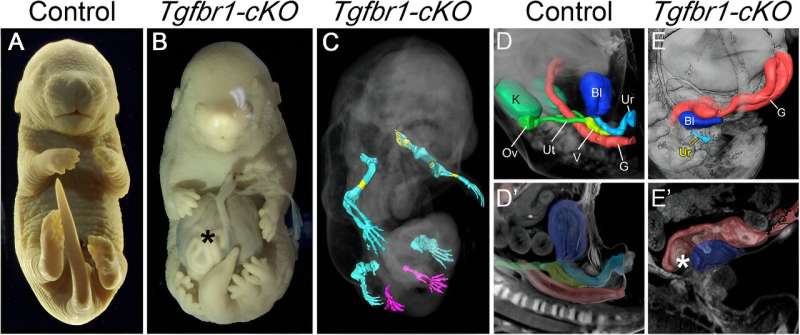April 3, 2024 report
This article has been reviewed according to Science X's editorial process and policies. Editors have highlighted the following attributes while ensuring the content's credibility:
fact-checked
peer-reviewed publication
trusted source
proofread
Inactivating the Tgfbr1 gene in mouse embryos results in extra limbs and no external genitals

A team of bioengineers at Instituto Gulbenkian de Ciência, in Portugal, has found that inactivating the Tgfbr1 gene in mouse embryos results in altered development in the trunk to tail region.
In their study, published in the journal Nature Communications, the group experimented with Tgfbr1 receptor proteins and were surprised to find they had engineered a six-legged mouse embryo with missing external genitalia.
Prior research has shown that in the majority of four-limbed animals, control of the hind limbs and external genitalia during development is centered on the same basic structures. For this new study, the research team genetically engineering mice to learn more about this development.
The team turned their focus to receptor proteins that develop based on Tgfbr1 signaling pathways—they turned them on and off to see what would happen to a mouse embryo as it developed. In one instance, after inactivating the gene and then letting the mouse progress through its development to approximately halfway to birth, the researchers found that it had six legs and no external genitalia and that the extra legs were growing where the genitalia were supposed to grow. When they repeated the process, they found the same result—six legs on both males and females with no penis on the males and no clitoris on the females.
The result came as a surprise to the research team and changed the course of their work to focus on why the outcome had happened. In taking a closer look, they found that the Tgfbr1 receptor proteins were directly involved in controlling the development of certain protostructures that become limbs or genitalia, and they did so by changing the way the DNA folds itself in the cells that make up the structures.
The findings offer a new venue for research surrounding Tgfbr1 signaling pathways and the role they play in the development of other body parts. The researchers suspect they may also play a role in the way the immune system develops and possibly the means by which cancer cells metastasize.
More information: Anastasiia Lozovska et al, Tgfbr1 controls developmental plasticity between the hindlimb and external genitalia by remodeling their regulatory landscape, Nature Communications (2024). DOI: 10.1038/s41467-024-46870-z
Journal information: Nature Communications
© 2024 Science X Network





















